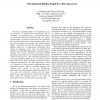Free Online Productivity Tools
i2Speak
i2Symbol
i2OCR
iTex2Img
iWeb2Print
iWeb2Shot
i2Type
iPdf2Split
iPdf2Merge
i2Bopomofo
i2Arabic
i2Style
i2Image
i2PDF
iLatex2Rtf
Sci2ools
ISCA
2002
IEEE
2002
IEEE
The Optimum Pipeline Depth for a Microprocessor
The impact of pipeline length on the performance of a microprocessor is explored both theoretically and by simulation. An analytical theory is presented that shows two opposing architectural parameters affect the optimal pipeline length: the degree of instruction level parallelism (superscalar) decreases the optimal pipeline length, while the lack of pipeline stalls increases the optimal pipeline length. This theory is tested by analyzing the optimal pipeline length for 35 applications representing three classes of workloads. Trace tapes are collected from SPEC95 and SPEC2000 applications, traditional (legacy) database and on-line transaction processing (OLTP) applications, and modern (e. g. web) applications primarily written in Java and C++. The results show that there is a clear and significant difference in the optimal pipeline length between the SPEC workloads and both the legacy and modern applications. The SPEC applications, written in C, optimize to a shorter pipeline length t...
| Added | 15 Jul 2010 |
| Updated | 15 Jul 2010 |
| Type | Conference |
| Year | 2002 |
| Where | ISCA |
| Authors | Allan Hartstein, Thomas R. Puzak |
Comments (0)

